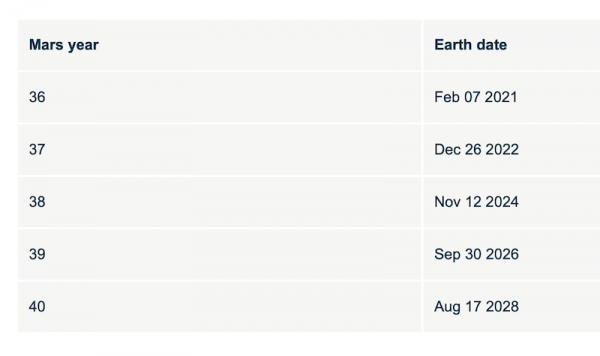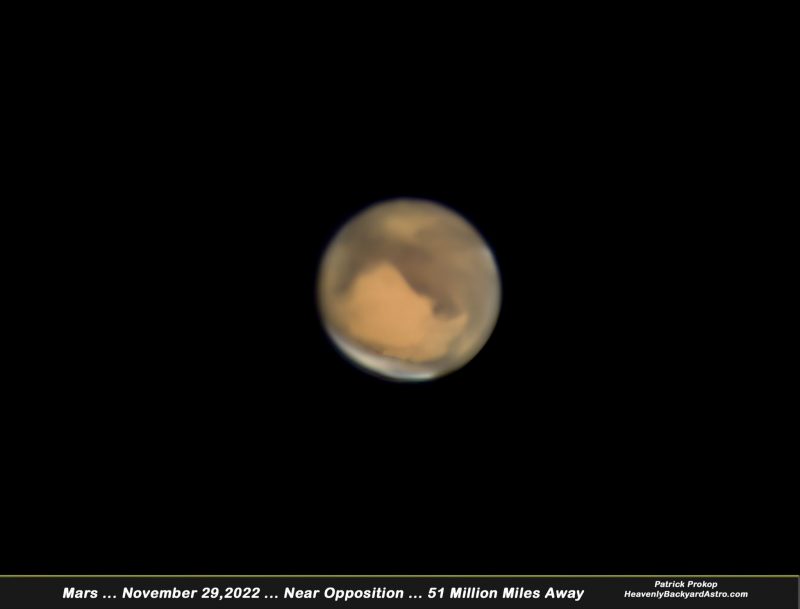
Mars calendar year
Earth and Mars formed together in the great primordial nebula that also created our sun. Both Earth and Mars are about 4.5 billion years old. But, just as for Earth, people have devised a system of human timekeeping for Mars. Earth’s most common calendar is the Gregorian calendar, placing us in the year 2022. The Mars calendar is much newer.
The count began at Mars Year 1, at the northern spring equinox of April 11, 1955. A major dust storm on Mars raged in the second half of that Mars year (sometimes called the great dust storm of 1956).
December 26, 2022, marks the start of Year 37 on Mars. Happy Mars new year!
Why label Mars years at all? Todd Clancy of the Space Science Institute was the first to describe a system for labeling Mars years, in a scientific paper published in the year 2000, describing temperature variations on the red planet. He established the system in orbit to enumerate Mars years and to help with data comparisons. In the years that have followed Clancy’s paper, other scientists also began using his system of Mars years, especially those who study Martian climate. Clancy and his co-authors described the choice of April 11, 1955 as “arbitrary”, but the 1956 great dust storm – falling in Mars Year 1 – provides a convenient marker.
Refining the Mars calendar year
Later, the system included a Mars Year 0 (defined as beginning May 24, 1953), and so allowing for negative year numbers. That’s similar to the use of A.D. or B.C. in the Gregorian calendar (or, more recently, CE or BCE).

Martian days and years
ESA provided these facts about timekeeping on Mars.
One year on Mars equals 687 Earth days. It takes almost twice as long as our Earth to orbit the sun. This means your age would be a lot less if you lived on Mars! If you would like to feel younger, just divide your current age by 1.88 and casually mention to your friends that that’s your real age … on Mars.
A Martian day is, like on Earth, the time it takes for the planet to make one revolution around its axis. This is called a sol. A sol is only slightly longer than an Earth day: 24 hours and 39 minutes.
Seasons on Mars
ESA provided these facts about seasons on Mars.
Mars has four seasons: winter, spring, summer and autumn. The planet’s position along its orbit around the sun determines the seasons. The Martian New Year begins with the northern equinox (northern spring, southern autumn). As Mars travels through its yearly trajectory, the planet’s axial tilt causes the northern hemisphere to receive more sunlight during the northern summer, and the southern hemisphere to receive more sunlight in northern winter, just like on Earth.
Unlike Earth’s seasons however, the seasons on Mars are not of equal lengths. This is because the orbit of Mars around the sun is more elliptical than that of Earth. For example, the northern hemisphere spring (southern hemisphere autumn) lasts the longest, 194 sols, and the northern hemisphere autumn (southern hemisphere spring) is the shortest season at 142 sols.
Mars’ elliptical orbit can have important consequences. During southern spring and summer, Mars swings by the sun closer and faster. The resulting increase in luminosity heats up the atmosphere, causing turbulence that lifts very fine particles from the Martian soil. For this reason, the second half of a Martian year often has fierce dust storms that can sometimes become planet-wide.
So how’s the weather on Mars?
ESA provided these facts about the weather on Mars.
And like on Earth, winters are cold and summers are warm on Mars, but the planet’s overall temperature is a lot cooler, it has a yearly average temperature of minus 60 degrees Celsius (-76 degrees Fahrenheit). In addition, the planet experiences different weather phenomena throughout the seasons. And a weather phenomenon that reappears every year around the southern spring and summer is the Arsia Mons Elongated Cloud, a cloud of ice crystals that can reach up to 1,100 miles (1,800 km) in length. It repeats for at least 80 sols and then disappears again during the rest of the year.

Bottom line: The Mars calendar year 37 begins on December 26, 2022. Happy New Year to Mars!











